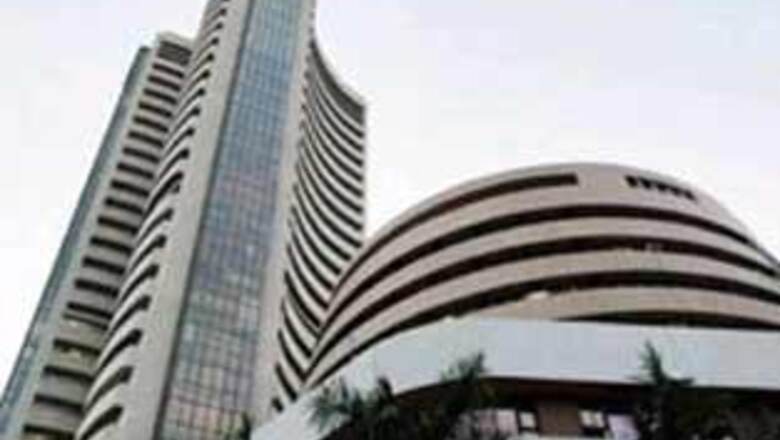
views
Nilesh Shah, MD and CEO, Envision Capital, said there is a high probability of the market going below October 2008 lows. "The markets can make a new low around monsoon, elections." He sees the Sensex trading between 6000 and 7000 on the lower side, and 9000 and 10,000 on the upside.
Nilesh Jasani, Director and Head of Research, Credit Suisse, too does not see the Sensex going beyond 12000 levels this year.
He said growth has to resume for deciding the broad range for markets. "Election results are only important for creating hopes of growth. The market is very well priced if we consider growth will not fall sharply."
Here is a verbatim transcript of the exclusive interview with Nilesh Jasani and Nilesh Shah on CNBC-TV18.
Q:The 5.3 per cent number did not go down very well with the street. Does that mean that there is worse to come for the economy? More importantly, do earnings expectations need to be lower even further?
Jasani: I know that we are all obsessed with gross domestic product (GDP) numbers, but in reality the quarterly GDP numbers have lost the meaning in this kind of turbulent environment. These are of course not the final numbers, they are not based on value added, they are based on things like credit growth and actual expenses and so on and so forth. So, there are a lot of problems with quarterly numbers. The reason why they are not reflecting people’s expectation at times is simply because they have become sort of meaningless at the moment.
In reality as we all know from industrial production numbers, from corporate sales numbers etc the economy in a way is doing a bit better compared to December, but definitely nowhere compared to where we wanted to be. Economic problems remain and that is going to be an issue for a while.
Q: Would you translate that to saying that earnings will decelerate further because earnings expectations have been lowered quite considerably by the market? Do you think they need to be adjusted further downward over the next few quarters?
Jasani: I think we have reached a point where FY09 once again does not matter. We are talking more and more about FY10. I personally feel the consensus on FY10 numbers for the Sensex is around 850. It may come down by another 15-20 per cent by the time the year gets over.
But having said that FY10 again is less of an important thing for the market, the most important thing for the market is when do we get a recovery and what kind of a recovery it is going to be? For example, if we get a good recovery by FY11, the market will be able to look through all these weak GDP numbers and weak earnings numbers and will be able to rebound. If at some point we give up hope on medium-term growth and we feel that it is not just a FY10 problem but FY11 is also going to be disappointing then we will have an issue.
Q: That is quite a scary prediction that even on the consensus estimate of 850, which means essentially no growth that analysts are expecting, do you think that could have to be cut by another 20 per cent?
Shah: At the moment, it looks to be a realistic scenario because the reality is that we have seen a huge contraction in GDP growth. From levels of about 9% GDP growth, we are now talking about 5% GDP growth. In the recent times, one of the agencies which have got reasonably right in terms of their projections has been the IMF. Basically, it is projecting India to grow at about 5%. So, if you look at a scenario of 5%, it is going to be very difficult for corporates to have even a double-digit revenue growth rate. In that kind of an environment, it is going to be difficult to sustain profitability and this is assuming that there are no material changes in the outlook on interest rates and commodity prices. I think the negative effect of operating leverage will also come into play. I think it is quite possible that in FY10 we would end up with de-growth rather than a flat scenario. If that were to happen, that could lead to continued disappointment for the equity markets.
Q: Many of the bigger global markets have broken below their October-November lows. Do you think India could do that as well if this is your earnings and economics forecast or do you think that may not happen?
Shah: I think the probability of that is very high and simply because the months of October and November – more so October – were reasonably violent for the Indian equity markets more so on the downside. If you look at some of the larger global equity markets like the US or euro markets, they were in a downhill but probably the downside was not as violent. But I think in India we had a particularly violent October. That down-journey in October was preceded by a reasonably good period of consolidation which happened with the markets between August and September.
So, if one were to look at that kind of a scenario, we are probably going through a similar situation where markets seem to find support between 8,500 and 9,000 and that is where the market has been for the last few months. It is quite possible that sometime probably between the second quarter of current calendar year between April and June when we have the earning season or when we have the elections and the outcome of elections and of course the outlook on monsoons, there is a good chance that probably markets will make a new low during that period.
Q: Do you agree with this view that 8,500 to 9,000 may hold out for the moment or do you think with the kind of earnings downgrades that you are talking about the market will have to adjust to lower levels or even form a fresh low in the next three-four months?
Jasani: From my point of view, I would disagree a bit with Nilesh Shah. I think in the near-term the market has shown a lot of resilience. We have gone through a lot in last four months. We have gone through Satyam episode, terrorist attack, some terrible economic numbers, and political disappointments etc but the market has somehow held on to 9,000. So, the good thing is that our ability to absorb shocks has gone up tremendously. I think there is very little investor presence at the moment in absolute terms. So, the foreign investors’ holding for example is worth barely USD 100 billion as of today. That is a very low number. I think all these things like foreign underownership or interest rates or inflation or valuations etc can protect only the downside for a while, they cannot create the upside.
At the end of the day, growth has to come back or hope of growth at least has to come back for the market to recover. If hope of growth somehow doesn’t come back by June-July or somewhere after the election, then a huge downside will open up and that is our point which will decide whether the range for going forward is going to be 9,000 to 12,000 or 6,000 to 9,000.
Q: You are saying that for this year in any scenario you don’t see an upside of more than 12,000 Sensex?
Jasani: I think that is going to be very difficult. For that we will have to be lucky and we haven’t been lucky off late.
Q: What is your best case scenario for the range for this year?
PAGE_BREAK
Shah: On the downside, I think level of 6,000 to 7,000 is the broad range where the markets could finally mark their lows during 2009. I think if we go as deep as that then levels like 9,000 to 10,000 could provide a strong resistance on the upside for 2009.
Q: I was reading one of your reports and you have been quite unequivocal about the fact that the biggest drag on earnings and on the markets could be the financial sector and that has played out in February where that sector has got completely decimated. Do you see further downward adjustments possible and what makes you so bearish on a sector which till February was about the most over-owned sector in the market?
Jasani: I think that exactly is the point that it is massively over-owned. For a variety of reasons, people have decided not to sell financials, for a variety of reasons people feel that it is the sector they should be selling last. But at the end of the day financial sector as we know all over the world is a virtual sector. It is a parasite sector. You cannot have a financial sector having earnings growth of 30% when the rest of the corporate world is having earning shrinking by 30%, which is what is happening at the moment, even if you adjust for mark-to-market (MTM) portfolio gains.
So, there is something that is not exactly right. Financial sector profit as a percentage of total is at all-time high kind of chart. That made lot of people worried in US and UK a couple of years back. Of course, over-ownership is another issue. So, if next X orders whether in absolute terms of relative terms is going to be in financials, it is not a sector where lot of people can buy lot more at least in relative terms.
Q: Do you think public and private sector banks which have been the underperformers this month, need to adjust even more?
Jasani: I think there still continues to be a strong case for a downward adjustment in valuations for the banking sector in the short- and near-term because they have had a huge sell-off in recent times. You might have some kind of pullback in the stock prices but the reality is that the broader expectation is that over the course of next one-two years there is definitely going to be a significant expansion in the NPAs of the banking system.
I think you are going to see a disproportionate increase in these sectors or the exposure which you would want to classify as stressed exposure or stressed assets perhaps could be in a range of 10-15 per cent. Even if half of that finally results into non-performing assets, we could end up in a situation where the NPAs increased from about 1.5-2 per cent at the moment to about 5-6 per cent going forward. I think that would be significant deterioration in the quality of the balance sheet for the financial system and for the banks.
In that kind of an environment, valuations of some of the banks particularly of some of the private sector banks may not be even able to hold on to current levels over a slightly longer-term horizon. So, the next four-six quarters are going to be extremely challenging for the banking stocks.
Q: Let me start with you on Tata Steel’s numbers. Would you buy this surprise in Tata Steel, the fact that the market responded positively on Friday when the consolidated numbers came in or do you think it is inevitable that Tata Steel will have to report losses during the next few quarters?
Shah: The numbers which have come out may probably mildly surprised the market and it might give some kind of a short-term trading move but I clearly think the outlook for the steel sector continues to be very challenging. There is still possibility of some downward pressure in steel prices. Demand offtake could remain sluggish for a while particularly in an environment where we are expecting 2009 to be virtually a flat year for the global economy or may be even a marginally negative year for the global economy and in that kind of an environment it is difficult to envisage a benign environment for commodity prices particularly for a commodity like steel. Tata Steel being a very large player is going to get affected because of that. So while in the short-term you might have some trading related upside but I still think that from a medium-term perspective there is going to be probably more downside to the stock rather than an upside.
PAGE_BREAK
Q: Is Credit-Suisse underweight on the ferrous sector stocks like Tata Steel or you’re buying beaten down valuations story there?
Jasani: It is not even beaten down valuations, although that has played a bit of a role but we are overweight on the sector for the last two or three-months. The argument is fairly simple that every short-term, every medium-term, every long-term rally whether it is in India or around the world will be led by commodities because that’s the only high beta sector where we have seen some fundamental adjustments, where we have seen people getting out, where we have seen capacity going out, production being cut and supply actually is fast responding to the new demand realities. So what we are saying is that if you have a bad view of the global markets, definitely it is not the sector for you because it is at the end of the day a high beta choice. But whenever you are trading in the market or whenever you think that the market is going to go up 15-20 per cent for whatever fundamental or non-fundamental reason, we believe that the sector that will lead the market on the way up is going to be metal sector around the world and also in India.
Q: What about autos that after some time has seen some rebound in February? Do you think that qualifies as a contrarian buy bet or not quite with the fundamentals it has?
Jasani: We are very positive on the sector. But definitely it is no longer a contrarian bet. I think finally the sector is being recognised as one of the better sectors by everyone. If you look at autos, cement, and metals, the good thing about these sectors is that fundamentals and expectations have adjusted, which is not the case with say banks or for that matter even with real estate where prices are yet to drop really meaningfully.
So these are the sectors that are essentially sitting at the edge. As soon as you see a recovery, whatever recovery anywhere, they are bound to rebound very rapidly even fundamentally from an extremely low base. In the share price of course you can get valuations on top of fundamental improvement. So those are the kinds of sectors that we like. As I said, you still have to believe in growth. If you give up on growth, these are not the sectors for you.
Q: The accident of this week was Ranbaxy. At Rs 160-170, would you buy that stock or you still can’t see any growth or upside there?
Shah: The outlook is pretty hazy. As it is the sector does not have consistency in terms of their numbers and it is hard to really forecast in terms of what basically the revenue outlook is or the profitability outlook is. I think as a company you probably undergo a few quarters of adjustment with a new owner and a new management. In addition to that, they are definitely facing certain challenges from a regulatory perspective.
So, I think there is basically a cloud of uncertainty around the company. So, I think in this kind of an environment it is best to probably stay away from the stock. If you are really keen on the pharma sector probably look out for other companies, and I think wait because at the end of it, Ranbaxy is a blue-chip, a flagship company. I think when things get better; there would probably be a better entry point in this stock.
Q: What about Satyam? What is your sense of where this story is headed, how many bidders will enter and whether you can get a pop by the time the final bids are in the auction?
PAGE_BREAK
Shah: It is really hard to speculate or anticipate in terms of how the bidding process will finally emerge and shape up and culminate into. It is really hard to take a call on that. But my sense is that I still feel that probably the right way yet to do this is probably split the company, demerge the business, demerge the people to a separate company, find a buyer for that who probably will pay a significantly better price and leave all the issues and negatives in the new company and let that be dealt with separately. I think that is probably a more logical and optimal outlook.
Q:The point that you are repeatedly making is that by the middle of the year you have got to get the sense that growth will pick up in the next calendar, otherwise you are going to ride the market down for quite a while. So, in your eyes it is not such a big election outcome rather than a growth outcome because a lot of people are pinning their hopes on a good election result and a post election resurrection of the markets at the moment?
Jasani: The election result is important only from the viewpoint of creating that growth hope. At the moment, in the name of elections a lot of things are forgiven, people are just waiting for that one big event. But after the election, essentially the government or policymakers or whoever we find as authorities will have to somehow stabilise the bottom. It is managing the bottom that is very critical. There are certain vicious cycles that haven’t even begun yet. We really don’t want those vicious cycles like those in non-performing loans, those on the fiscal accounts to even start because once we go down to those vicious cycles things will get very ugly.
So our best case is we move on to the next growth cycle very quickly. In that case we don’t see much more fundamental deterioration than what we have seen so far. In that case, the market is very well priced, extremely beautifully priced I would say. If not, things will get uglier and as I said, it won’t be just an FY10 thing but even in FY11 we will still be talking about the same issue – growth is not there and that is a big issue.
Q: If you were to assign probabilities to events post June on whether growth will pick up or not, from what you can see right now, how would you assign those probabilities? What would convince you post June, July that growth is really turning around?
Jasani: I would say that there is more than even probability that things would be okay. At the end of the day, as much as I hate these relative arguments, we are having about 25-26 per cent savings rate – we are talking about the average savings rate not the cyclical P/E – and with that kind of savings rate as long as we manage the bottom we should be able to grow at 5.5-6% easily over the next few years. That will be one of the best growth rates in the world. I think that argument has been made a lot of times.
The critical thing out here is to manage the bottom, to provide some sort of a floor to the fall that we are witnessing. That is where I think authorities play a huge role. I would say that 55-60 per cent probability we’ll be fine. But it is very easy to mess up things as well.
More from moneycontrolExperts list trading strategies for next week



















Comments
0 comment